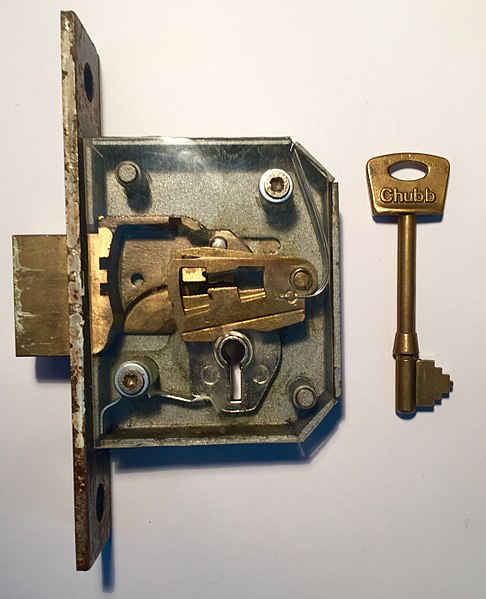Mortice lock

|
| A common lever-type mortice lock in the UK. |
Contents |
[edit] Introduction
A mortice lock (or mortise lock) is a lock that is carved or cut into a pocket on the side of a door or piece of furniture. This type of lock is sometimes used as a second lock for increased security and is commonly found in residential applications.
[edit] History
The mortice lock was commonly used in older buildings in the United States. Two of the country’s early presidents, Thomas Jefferson and James Madison both mentioned mortise locks as their security devices of choice. In 1788, Thomas Jefferson wrote to John Trumbull to request “mortise locks” on a carriage he wanted made to his specifications.
In 1798, James Madison included a reference to the devices (“mortise locks which I accordingly prefer”) in a letter to Jefferson. The letter followed with a review of matters of state. The discussion of locks came before the discussion of politics.
[edit] Operation
The locking body of a mortice lock is installed in the door, piece of furniture or other object while the box keep is installed in the facing frame. The mortice lock works by projecting its locking device (or lever) into the corresponding space on the facing side of the door frame or other object. A key is often used to operate the bolting mechanism and move it into the locked or unlocked position.
Mortice locks can create a layer of security on top of that which has been provided by standard cylindrical locks. Commonly available in deadlock and sashlock varieties, mortice locks are used in residential and commercial properties throughout the United States and Europe.
NB Code of practice: Hardware for fire and escape doors, Issue 5, published by DHF and GAI in November 2024, defines a deadlock as a: ‘Lock that contains only a deadbolt.’ Where a deadbolt is a: ‘Bolt that is operated in both directions by a key, handle and/or thumb turn.’
[edit] Related articles on Designing Buildings
Featured articles and news
The UK’s largest air pollution campaign.
Future Homes Standard, now includes solar, but what else?
Will the new standard, due to in the Autumn, go far enough in terms of performance ?
BSRIA Briefing: Cleaner Air, Better tomorrow
A look back at issues relating to inside and outside air quality, discussed during the BSRIA briefing in 2023.
Restoring Abbotsford's hothouse
Bringing the writer Walter Scott's garden to life.
Reflections on the spending review with CIAT.
Retired firefighter cycles world to raise Grenfell funds
Leaving on 14 June 2025 Stephen will raise money for youth and schools through the Grenfell Foundation.
Key points for construction at a glance with industry reactions.
Functionality, visibility and sustainability
The simpler approach to specification.
Architects, architecture, buildings, and inspiration in film
The close ties between makers and the movies, with our long list of suggested viewing.
SELECT three-point plan for action issued to MSPs
Call for Scottish regulation, green skills and recognition of electrotechnical industry as part of a manifesto for Scottish Parliamentary elections.
UCEM becomes the University of the Built Environment
Major milestone in its 106-year history, follows recent merger with London School of Architecture (LSE).
Professional practical experience for Architects in training
The long process to transform the nature of education and professional practical experience in the Architecture profession following recent reports.
A people-first approach to retrofit
Moving away from the destructive paradigm of fabric-first.
International Electrician Day, 10 June 2025
Celebrating the role of electrical engineers from André-Marie Amperè, today and for the future.
New guide for clients launched at Houses of Parliament
'There has never been a more important time for clients to step up and ...ask the right questions'
The impact of recycled slate tiles
Innovation across the decades.
EPC changes for existing buildings
Changes and their context as the new RdSAP methodology comes into use from 15 June.























